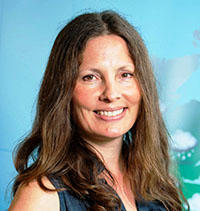Dr Beverley Adams-Groom

Senior Palynologist and Pollen Forecaster
School of Science and the Environment
Biological Sciences
email: b.adams-groom@worc.ac.uk
tel: 01905855411
Beverley’s background is in Environmental Science, which is currently applied in teaching on the University’s Environmental Management and Sustainability course. Beverley is a leading expert in pollen forecasting in the UK, until recently providing pollen forecasts in association with the UK Met Office. The main discipline for this work is Aerobiology, which is the study of the production, emission and dispersal of biological particles (bioaerosols). Beverley is also involved in the field of Palynology, which is the study of microscopic biological particles in the environment (mainly pollen and spore identification). She currently applies this in the quality assurance of honeys for the UKs honey companies and analysts. This is a form of forensic work, involving identification of pollen extracted from honey of various countries to ensure the origin and floral composition and to check for contamination or adulteration.
Qualifications
- BSc (Hons) Environmental Science (Worcester)
- PhD by Publication in Forensic Palynology (Worcester)
Teaching Interests
Beverley teaches UMS students and advises MRes and PhD students, as well as independent study students. Currently teaching on the following courses:
- BIOL1008 Introduction to Forensic Science
- BIOS4002 Integrated Masters in Applied and Commercial Research
- BSc Environmental Management and Sustainability
Research Interests
Beverley has recently published and collaborated on studies examining long term pollen season trends in the UK and internationally, as well the impacts of climate change on these.
Recent Publications
- Sofiev, M. , Palamarchuk, J. , Kouznetsov, R., Abramidze, T. , Adams-Groom, Beverley, et al. (2024) European pollen reanalysis, 1980–2022, for alder, birch, and olive. Scientific Data, 11 (1082). pp. 1-19. ISSN 2052-4463 https://eprints.worc.ac.uk/14294/
- Hanson M, Petch, Adams-Groom B, Ottosen T-B, Skjoth CA. 2024. Storms facilitate DNA from leaf fragments outside the main tree pollen season. Aerobiologia.
- Tummon F, Adams-Groom B , Antunes C, Bruffaerts N, Buters J, Carinanos P, Celenk S, Choel M, Clot B, Cristofori A, Crouzy B, Damialis A, Rodriguez Fernandez A, Fernandez Gonzalez D, Galan C, Gedda B, Gehrig R, Gonzalez-Alonso M, Gottadini E, Gros-Daillon J, Hajkova L, O'Connor D, Ostensson P, Oteros J, Pauling A, Perez-Badia R, Rodinkova V, Rodriguez-Rajo J, Ribeiro H, Sauliene I, Sikoparija B, Skjoth C, Spanu A, Sofiev M, Sozinova O, Srnec L, Visez N and de Weger L. 2024. The role of automatic pollen and fungal spore monitoring across major end user domains. Aerobiologia. pp. 1-19. ISSN 1573-3025 https://doi.org/10.1007/s10453-024-09820-2
- Pashley CH, Skjoth C, Hemming D, Adams-Groom B, Borman A, Johnson E, Anees-Hill S, Todkill D, Elliot A, Lam H, Goode E-J. 2023. Chapter 6. Outdoor airborne allergenic pollen and fungal spores. In: UKHSA. Health Effects of Climate Climate Change in the UK.
https://www.gov.uk/government/publications/climate-change-health-effects-in-the-uk.
- Carl A. Frisk, Beverley Adams-Groom, Matt Smith, Isolating the species element in grass pollen allergy: A review, Science of The Total Environment, Volume 883, 2023, 163661, ISSN 0048-9697, https://doi.org/10.1016/j.scitotenv.2023.163661.
- Apangu, G.P., Frisk, C.A., Adams-Groom, B. et al. Using qPCR and microscopy to assess the impact of harvesting and weather conditions on the relationship between Alternaria alternata and Alternaria spp. spores in rural and urban atmospheres. Int J Biometeorol (2023). https://doi.org/10.1007/s00484-023-02480-w
- Frisk CA, Apangu GP, Petch GM, Creer S, Hanson M, Adams-Groom B, Skjøth CA. Microscale pollen release and dispersal patterns in flowering grass populations. Sci Total Environ. 2023 Apr 5:163345. doi: 10.1016/j.scitotenv.2023.163345.
- Apangu G, Adams-Groom B, Satchwell J, Pashley CH, Werner M, Kryza M, Szymanowski M, Malkiewicz M, Bruffaerts N, Hoebeke L, Grinn-Gofron A, Grewling L, Gonzalez Roldan N, Oliver G, Sindt C, Kloster M, Skjoth C. 2022. Sentinel-2 satellite and HYSPLIT model show that local cereal harvesting substantially contributes to peak Alternaria spore concentrations. Agricultural and forest meteorology. Journal of Agriculture and Forest Meteorology, 326 https://doi.org/10.1016/j.agrformet.2022.109156
- Buters J, Clot B, Galán C, Gehrig R, Gilge S, Hentges F, O’Connor D, Sikoparija B, Skjoth C, Tummon F, Adams-Groom B, Antunes CM, Bruffaerts N, Çelenk S, Crouzy B, Guillaud G, Hajkova L, Seliger AK, Oliver G, Ribeiro H, Rodinkova V, Saarto A, Sauliene I, Sozinova O, Stjepanovic B. 2022. Automatic detection of airborne pollen: an overview. Aerobiologia. ISSN Electronic: 1573-3025 Print: 0393-5965
- Adams-Groom B, Selby K, Derrett S, Frisk CA, Pashley CH, Satchwell J, King D, McKenzie G, Neilson R. Pollen season trends as markers of climate change impact: Betula, Quercus and Poaceae. Sci Total Environ. 2022 Science of the Total Environment, 831 (154882). https://doi.org/10.1016/j.scitotenv.2022.154882
- Rowney FM, Brennan GL, Skjøth CA, Griffith GW, McInnes RN, Clewlow Y, Adams-Groom B, Barber A, de Vere N, Economou T, Hegarty M, Hanlon HM, Jones L, Kurganskiy A, Petch GM, Potter C, Rafiq AM, Warner A, ‘The PollerGEN Consortium’, Wheeler B, Osborne NJ, Creer S. 2021. Environmental DNA reveals links between abundance and composition of airborne grass 1 pollen and respiratory health. Current Biology, 31: 9: 1995-2003 https://doi.org/10.1016/j.cub.2021.02.019
- Adams-Groom B, Skjoth C, Selby K, Pashley C, Satchwell J, Head K, Ramsay G. 2020. Regional calendars and seasonal statistics for the United Kingdom’s main pollen allergens. Allergy, 75 (6): 1492-1494. https://doi.org/10.1111/all.14168
- Adams-Groom B, Martin P, Sierra-Banon A-L. 2019. Pollen characterization of English honey from Worcestershire, West Midlands (UK). Bee World, 97 (2): 53-56 https://doi.org/10.1080/0005772X.2019.1698105